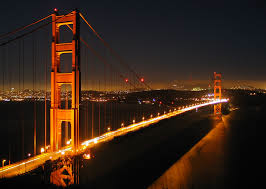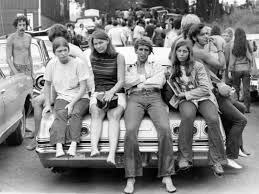
IF YOU ARE GOING TO SAN FRANCISCO
SCOTT MCKENZIE
Counterculture of the 1960′
“If You’re Going to San Fransisco…Be sure to wear some flowers in your hair.”
The Hippie Lifestyle
The period of the 1960’s was a time of rapid social change and immergence in the United States. A leftist and liberal philosophy within the society, coupled with the powerful anti-Vietnam War movement, made the 1960’s an extremely memorable era. Fueled by the urge to break away from the conservative mindsets of the ideal 1950’s family, the counterculture generation took a stand against such restricting factors. In doing so, the “hippie” culture took root and spread throughout the United States, mainly amongst the young, college students who were attracted to such a free lifestyle. Philosophies such as free love, communal living, and experimentation with various mind-altering drugs were trademark of the hippie lifestyle. Partaking in activities such as these separated the people from the previous churchgoing, family oriented decade and a powerful counterculture developed.
“If it feels good, do it,” sums the entire attitude of the hippie generation. Each lived a carefree life in which they could express themselves to the fullest and carry on unrestricting customs that were never before seen in society. Constraint of the body as well as the mind was ruled non-cohesive in the beliefs of this new generation. The people wanted to be as free as possible and did so by expressing themselves in unlimited ways. The common characteristics of the hippie were long hair, second-hand, colorful clothing, flowers and beads as well as sandals or bare feet. Sexual experimentation thrived through the culture as free love and casual relations took the place of family values and strict Christian beliefs in a lifetime partnership.
“The counterculture questioned sexual morality and proposed many different models: extended sexual families, sex orgies, sex-therapy groups, acceptance of homosexuality and, most of all, a positive, joyful celebration of sexuality, as opposed to the uptight morality of the previous generation,” (Miles 13).
The open and free sexuality brought about a huge shift in the culture of the United States. People of the counterculture no longer felt the harsh constrictions of society and they each experienced a strong feeling of liberation because of this. When birth control became readily available to the public, women were given more freedom in their sexuality and this fueled the philosophy of free love. Such freedom among the hippie community sparked questioning of sexual roles and demonstrated how the hippie culture was contributing largely to the change of customs in society.
As contemporary personal values and beliefs flourished, people of these similar views tended to join together through communal living. Many hippies of the nation migrated to the West coast of the United States after they dropped out of college to express their freedom and beliefs in a nonrestrictive society.
“Searching for a place in which they could feel free to express their political views and creative spirit, many found themselves in California or New York. Most gravitated to a desolate part of San Francisco known as the Haight-Ashbury District. This neighborhood, close to San Francisco, State College, provided homes for many students,” (Hoy 2).
People of the counterculture found communal living beneficial to their personal needs as well as to their essential beliefs. When living with other people who possess the same views and methods of survival, the group generally tends to conflict with one another much less. When people find benefit in easier living, namely in communes, they are able to agree with the people around them, in turn creating a generally peaceful environment. One of the most popular hippie gatherings was in the Haight-Ashbury District in San Francisco, California. Sparked by the opening of a Psychedelic shop that sold books on drugs and oriental philosophy, flutes, beads, and other hippie paraphernalia. The youth of the counterculture were attracted to this and were quickly drawn to the area. The district provided places to live for the growing population of college dropouts and fed the culture that was driving the counterculture of the United States. There are numerous cases, however, in which when not controlled or peaceful, communes can be a negative thing. If not cautious, the commune could turn into a cult. One of the most famous “communes” of the era was under Charles Manson, a crazed murderer and essential madman. He is highly notorious for acts of sodomy, violent murder, rape, and robbery, among numerous other serious felonies (Miles 272). Manson’s cult is prime example of how communal living could be an evil institution. Although there are unfortunate cases such as this, for the most part, communal living was beneficial to the people within the institution and was a peaceful way of sharing the wealth of life.
Along with free love and revolutionary philosophies, the drug culture was a main and important attribute to the new counterculture of the United States. It was not uncommon for hippies to have marijuana or LSD in their possession. Mind altering drugs were extremely popular amongst the youth culture because they were able to free their minds more effectively.
“While listening to this (psychedelic rock) some hippies smoked marijuana or took LSD (lysergic acid diethylamide), a powerful drug that includes hallucinations,” (Hoy 2).
Getting high was the ultimate method for a hippie to release their minds and relieve any sort of impurity or stress in their life. Drugs were a lifestyle, providing income for the majority, usually just enough money for personal marijuana purchase and basic living costs. Rising celebrities, mainly on the rock scene front, such as Jimi Hendrix and The Beatles experimented in the drug culture. Hendrix dabbled heavily in LSD while the Beatles experimented with LSD as well and marijuana on occasion. Paul McCartney of the Beatles answers questions,
“’Do you think you have encouraged your fans to take drugs?’
‘I don’t think it will make any difference. You know, I don’t think it will make any difference. You know, I don’t think my fans are going to take drugs just because I did,’” (Miles 237).
The celebrities claim to not want to directly influence the fans into taking on the drug culture, but were rather experimenting with it for their personal curiosity or interest. Even though marijuana was technically illegal, it was only the rich and famous who were caught and penalized with scandal. This was mostly because the conservative remnants of society rejected the hippie lifestyle and its influence on society as a whole. Conservatives took action and turned events into scandals in order to downplay and discredit the hippie movement. Although drugs such as marijuana and LSD have been illegal, except for medicinal uses, before and during the 1960s, they were not uncommon in the slightest. Drugs were readily available to the common hippie of the 1960s and allowed them to free their mind and experience an alternate way of life.
The hippie lifestyle matched that of any other new and different way of life, revolutionary and for the most part, popular. The 1960’s was a period in which college students “tune in, turn on, and drop out”, like psychedelic drug research advocate, Timothy Leary states. The revolutionists of the era expressed their New Leftist beliefs by expanding their sexual freedoms, living together in communes, and involving themselves in the powerful drug culture which would allow them to ideally live by their free beliefs. The hippie lifestyle was truly a side of society which effectively expressed and practiced their ways of life alongside the disapproving conservative America of the previous decade.




